

 The Accurate Reloading Forums
The Accurate Reloading Forums  THE ACCURATE RELOADING.COM FORUMS
THE ACCURATE RELOADING.COM FORUMS  Guns, Politics, Gunsmithing & Reloading
Guns, Politics, Gunsmithing & Reloading  Reloading
Reloading  runout importance?
runout importance?Go  | New  | Find  | Notify  | Tools  | Reply  |  |
| One of Us |
I have been reloading for years now, and I have never measured runout. How important is it, and how would one measure it. I primarily load for accuracy hunting loads and I want the most accurate loads possible. thanx, Mark | ||
|
| one of us |
This is always a fun and hotly disputed topic. I will say that the degree of "importance" varies from gun to gun. There are those out there that swear up and down that it makes a HUGE difference. Others will say it does not. I do try and make my ammo as straight as possible as it certainly can't hurt but I no longer put as much faith in it being necessary for good shooting. There is a guy over at long range hunting chatrooms that says when he is fireforming his rounds for a wildcat gun he winds up with ammo that has .025" runnout....yes that is .025 (not .0025".) His gun, while fireforming those rounds will shoot .75" 300 yds groups so obviously runnout doesn't shake thing up too bad for him. | |||
|
| One of Us |
For long range accuracy it is important because of trajectory. A bullet that is turning 200,000+ rpms that measures .001 TIR vrs. one that is turning the same rpms that checks .008 TIR will shed its velocity faster than the .001 bullet and this is only seen at long range with more bullet drop. Think of a football pass that is turning a tight spiral vs a badly thrown "duck" even though they left the hand with the same energy the one turning on it's centerline is more efficient...period! ________________________________________________ Maker of The Frankenstud Sling Keeper Proudly made in the USA Acepting all forms of payment | |||
|
One of Us |
My opinion is that it is important to chase concentricity because it will make you pay attention to all the issues that create runout. While finding and correcting those issues you will be learning and improving your reloading methods. As far as demonstrable differences, I did a test when I first got my Bersin tool 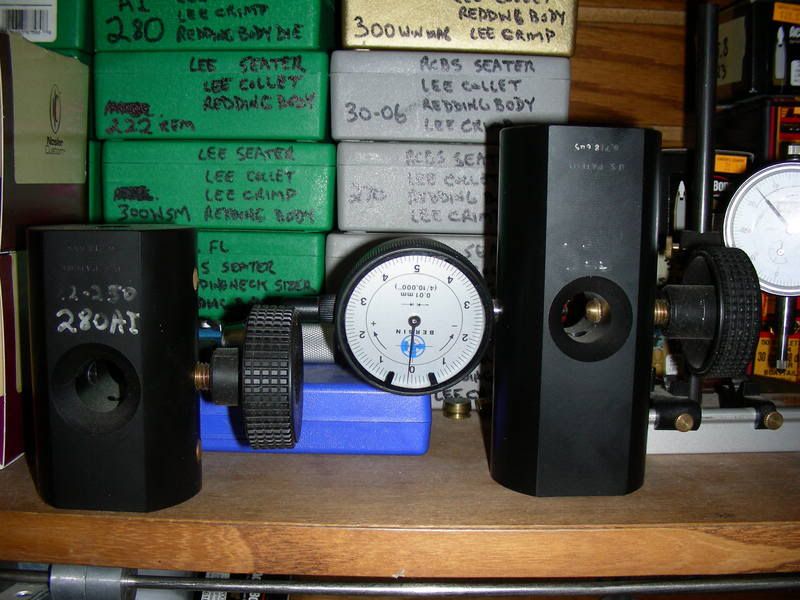 which allows you to push on the bullet and actually greatly reduce runout. It was with a consistant 30-06 and it was 10 rounds with typical runout of .001" to .004" (not that bad compared to some) 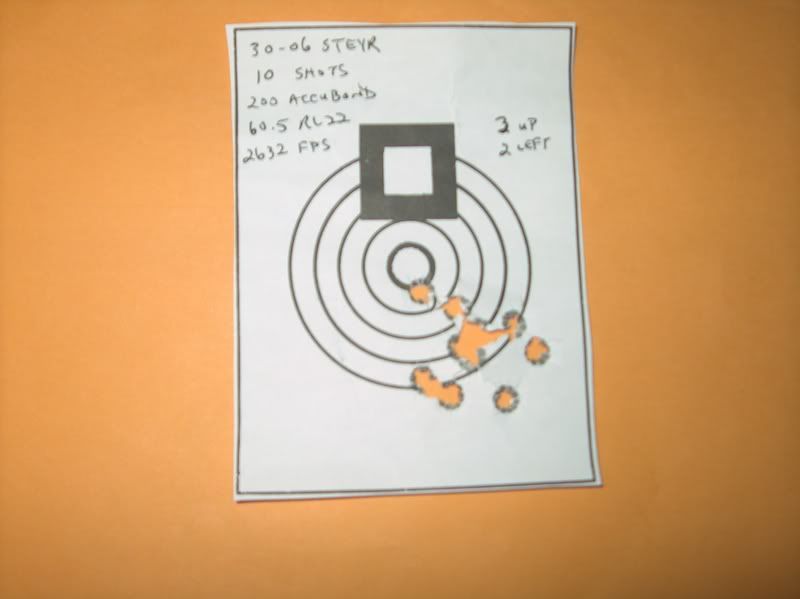 and the Bersined loads with runout less than .0005" (one flyer-flinch when that 30-378 went off on the next bench right when I was sqeezing the trigger) 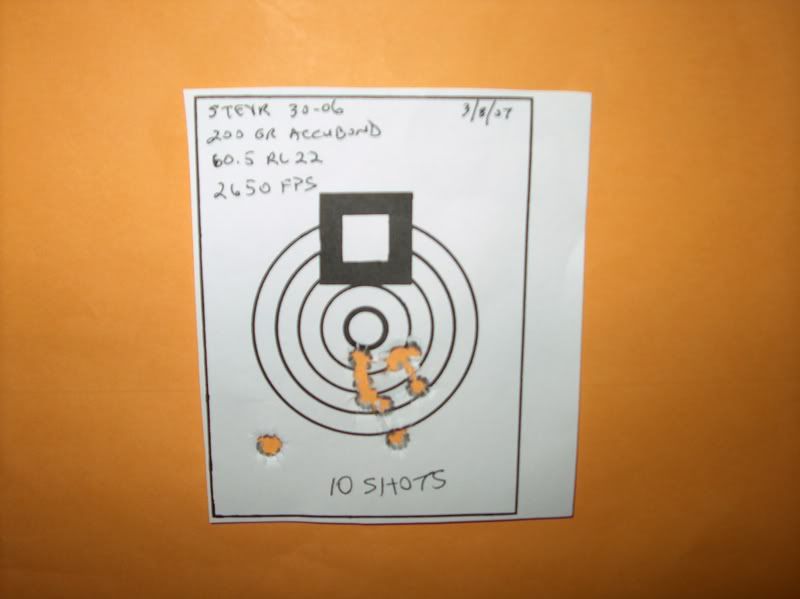 There is a slight improvement in the accuracy. If you are loading for hunting accuracy at less than 300 yards then it is not necessary, but if you have and adequate gun and scope and want to shoot at longer yardages then it is one of the many variable you need to control. ____________________________________ There are those who would misteach us that to stick in a rut is consistency - and a virtue, and that to climb out of the rut is inconsistency - and a vice. - Mark Twain | Chinese Proverb: When someone shares something of value with you and you benefit from it, you have a moral obligation to share it with others. ___________________________________ | |||
|
| One of Us |
Roll your loaded ammo across a glass-top table. If you can see wobble, you have run-out; if you can't, you're OK. The final determination is performance on target. ________________________ "Every country has the government it deserves." - Joseph de Maistre | |||
|
| One of Us |
I recommend you pick up a copy of The Precision Shooting Reloading Guide edited by Dave Brennan. I believe understanding runout is very important. | |||
|
| One of Us |
LOL....my table doesn't read in .001 nor do my eyes. I could roll a round accross my Starrett pink granite surface plate and yes see the bullet tip "wobble" but my eys won't tell me how much the round is out of concentric. But my run out gage that I made will .001 Another useless step??? To each his own. But this step will tell me if a bullet is out AND how much. I mark each round with the amount of runout it has with a small # at the base of the cartridge with a sharpie marker. I then shoot the worst for fouling and practice and use the best for checking groups and hunting. ________________________________________________ Maker of The Frankenstud Sling Keeper Proudly made in the USA Acepting all forms of payment | |||
|
| one of us |
One thing is for sure, there's no such thing as ammo that is TOO concentric. The question is how much effort are you willing to spend in getting your ammo how concentric. The Bersin tool is a great way to measure and straighten your ammo to less than .002. I think you can see a 1/4 to 1/2 MOA improvement moving from .010 to .002 or at least I have in several different accurate rifles I've tried it in. There's lots of variables and a 1/4 MOA improvement isn't worth the effort necessary for most average hunting reloaders. Right now unless you are well heeled and interested enough to invest in a $350 Bersin tool, I'd wait for the new $100 Hornady tool to come out that might do the same straightening job that the much more expensive Bersin tool does. I hope to get a Hornady as soon as they come out and will compare it to the Bersin, we'll see how well it works......................DJ ....Remember that this is all supposed to be for fun!.................. | |||
|
| One of Us |
With some practice you can see .003 TIR. That is total indicated runout. That means your bullet tip is off axis .0015. When you get it good enough that you can't see it runout, you probably are about as good as your are going to get . | |||
|
| One of Us |
Thought I might save the OP the cost of a run-out gauge to figure out if he has a problem with his hunting ammo. ________________________ "Every country has the government it deserves." - Joseph de Maistre | |||
|
| One of Us |
Runout and concentricity are important if you want the best accuracy your rifle is capable of delivering. I decided several years ago to leap frog over measuring runout by going directly to the source of the problem, and now use Wilson straight line seaters, or custom made seaters similar to the Wilson's. It seems to be working well as I'm getting better accuracy than I did before switching over, and I don't have to do any measuring either because they are as straight as I can get them with the Wilson's. I think in all honesty, runout and concentricity play a part in overall accuracy, just like good bullets, good barrels, good gunsmithing chamber work, etc do. Don | |||
|
| One of Us |
How important it is depends on several variables and that's why there is so much division about it. Seems some folk feel if it helps them it's important but if it doesn't help (them) it isn't. Actaully, the effects are clear and well documented on targets. One significant variable that many overlook is the chamber and throat have a huge effect. A loose throat is VERY susceptable to bullet run-out effects. A tight throat tends to force a tilted bullet into better bore alignment and shoots better than it's Run-Out might indicate. As said above, run-out can't be good. There are variable ways it can come into being. Loosely fitted seaters are common but bad case necks are more frequently the worst problem. No seater can push bullets straight into a bent neck! A conventional sizer die's poor expander button pulling through an uneven thickness neck is perhaps the most frequent cause of bent necks. Accuratly eye-balling a rolling cartridge is, to put it mildly, difficult. And no one can see run-out of a cartridge neck itself unless it's truly horrendeous. Reloaders wishing to correct for cartridge run-out must first know where it occurs in the loading process. To measure run-out of either cartridge necks or bullets, we must use a common dial indicator mounted on a simple concentricity gage. The exact methods vary a bit but each maker has instructions for their tool's use. I believe the Sinclair tool and their inexpansive (sorta) dial indicator is the simplist to use and still get excellant measurements. | |||
|
| One of Us |
Throw away your expander ball, never think about concentricity again, avoid this topic, and live a happy life. Can't stop thinking about it? If the ammo is badly bent, the chamber will bend it to within ~ 0.004" of straight, and only add ~2" to your 30-06 groups, according to the army, NRA, and A. A. Abbatiello. Obviously, the 6mmPPC chambers with .262" neck and turned brass would be bent much straighter in that tight chamber than .004" out of whack. | |||
|
| One of Us |
Mark If you are loading for big game hunting using a standard commercial made sporter then I'd not get too concerned about "run out". With quality bullets from red, green, yellow or Nosler and using good loading techniques that kind of rifle will not really know the difference between rounds with .008" runout or those with .003" runout. This is especially the case if you shooting under 300 yards as someone mentioned. Most FL sized (not neck turned) cases will have several rounds out of 20 with upwards of .008"+ run out simply due to uneven thickness of the necks or to resistance when dragged over the expander button. Many times too much neck tension causes more run out because of uneven expansion (thinner part of the neck expansions first and thickest part may not expand at all). If you are FL sizing and the bullet goes to or below the neck base then the thickening of the base of the neck (so callet "donut effect") also causes non concentric seating of the bullet which of course means more run out. However, if you have a very accurate target type rifle and/or are using neck sized fire formed cases then run out can indeed be an issue with accuracy. The more concentric the run out the more accurate it will be. I would not and do not depend on the throat straightening out excessive run out. For such rifles I keep cases (all the same lot of manufacture) segregated in 100 round MTM cases. I turn the case necks minimally for consitant neck thickness. I also use quality bench rest or match type dies for loading. I use old Lee Target loaders to inside neck ream my .308W and .223 match cases. I use a Forster outside neck turning tool for all other cartridges. With my long range .30 cal target rifles I've found that bullets loaded with more than .003" run out can shoot outside the X ring. With my .223 match rifles it is .002". I "spin" each round loaded and put them in the cartridge box in ascending order of run out. Those with .000 to .002" run out I will use at long range (600 to 1000 yards). Those with more than .002 up to .003 I use at 300 to 500 yards and those very few (2-5 out of 100 rounds) with larger than .003" I use at 200 yards. With my varmint rifles (.223, 22-250, 243 and 6.5-280) I turn the necks minimally to a consistent thickness also and load. With the .223 I do not spin for concentricity because I shoot too many of them. I sometimes spin the 22-250 and 243s but with the neck turning and use of a Forster benchrest NS die run out is never over .003" and most are well under .002". I do always spin the 6.5-280 as I use the longer 120 BTs in them. Run out is most often under .002 but an occasional one of .003" will slip in. I sort those out for the shorter range shots or foulers. I must also confess to neck turning most of the cases used for serious big game hunting and spinning them for run out. The M70 Winchester '06 may not know the difference between .003 and .008" run out but my mind does. Where I hunt deer and elk longer shots than 300 yards are possible. Confidence in your rifle and load is many times a great part of the equation of a longer range shot. Knowing my ammo is concentric makes me more confident, I don't think about when taking such a shot and thus can concentrate on the things I need to like wind and the angle of the shot along with a couple other variable. Neck turning may or may not improve the accuracy of your loads with your rifle. However if done correctly neck turning sure won't hurt the accuracy. Were I you I would study up on it and try it. Larry Gibson Before I get a lot of criticism (on this forum...tell me it's not so | |||
|
| one of us |
Run out is VERY important for accuracy. But many blame the bullet seater when it is the size die that is to blame. Over sizing brass and then pulling an expander out will bend shoulders. Brass thickness of the necks should be evened out first, then minimum sizing is needed. Redding collar dies are best so no expander is needed. I used to send dies and fired cases to Redding to have the size dies lapped for minimum sizing and the expanders would barely be felt coming out of the brass. The very worst brass is Weatherby with the rounded shoulders, they get out of line easy. After work is done to the die, I would hold sub 1/2" groups at 100 yd all day with a .300 Weatherby. Working loads from minimum to maximum never had a single group go over 1/2". Larry is right but I do not accept over .002" run out. I turn all rifle brass just to even it out, even if it is just a skim cut to the thin spot. A bullet started off center will stay off center, get them as straight as you can. | |||
|
| One of Us |
Does that include zebra at 300 yards with a .223? | |||
|
| one of us |
Hey Mark, I've never measured Run Out on any cartridge I've ever loaded. Run Out is of no concern to me at all, because I P-FLR all my Bottle Neck Cases. When you P-FLR, the result is that the Case is held in a slightly Compressed state between the Bolt Head and Chamber Shoulder. That causes the CenterLine of the Case to be in the closest alignment possible with the CenterLine of the Chamber. Any other Method allows the Case to either lay on the bottom of the Chamber in a CRF rifle or shoved to one side in a PF rifle design. All the Bumping Back that the Neck Sizing folks goes through creates the "loose Case" condition. But a lot of them shoot fairly well with NSing, chasing Run Out and then letting the Case lay crooked in the Chamber. I Fully Prep all my Cases and Weight Sort them, where a lot of folks consider that a total waste of time. I consider fretting over Run Out a waste of time, since I P-FLR. But if a person builds confidence in their Loads by doing it, that is what they should do. Good Hunting and clean 1-shot Kills. | |||
|
| One of Us |
Hot Core, Good posting. I don't measure runout either, and run out is important for best accuracy. However, I make sure my rounds have minimum runout by loading the rounds as best as I can to preclude any runout. Here are three targets I shot last year with rounds loaded using Wilon Seaters as well as doing what Hot Core suggests. These rounds don't need measuring as they are the very best I can load. There are other things I do to insure best accuracy, but this thread is about runout, so that's what I'm addressing. I have other targets with similar groups for a lot of different rifles, but haven't taken pix of them. These are 100 yard targets. 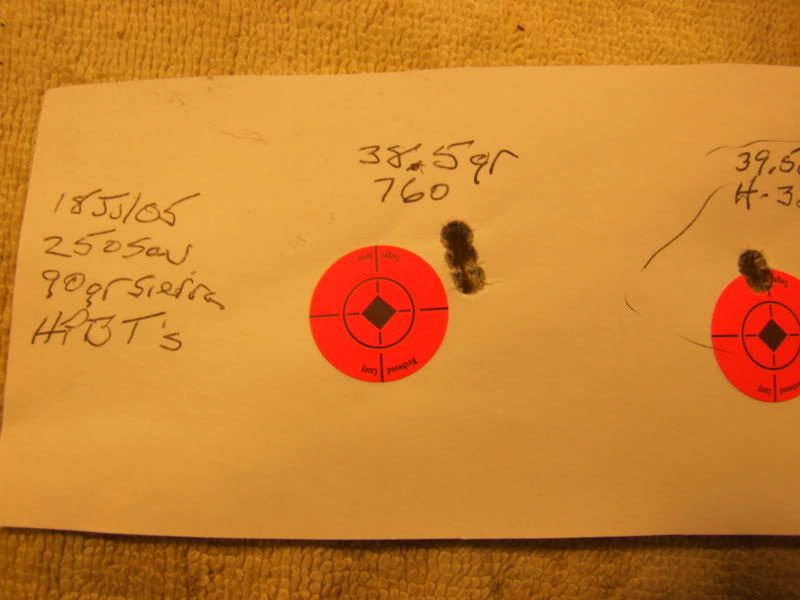 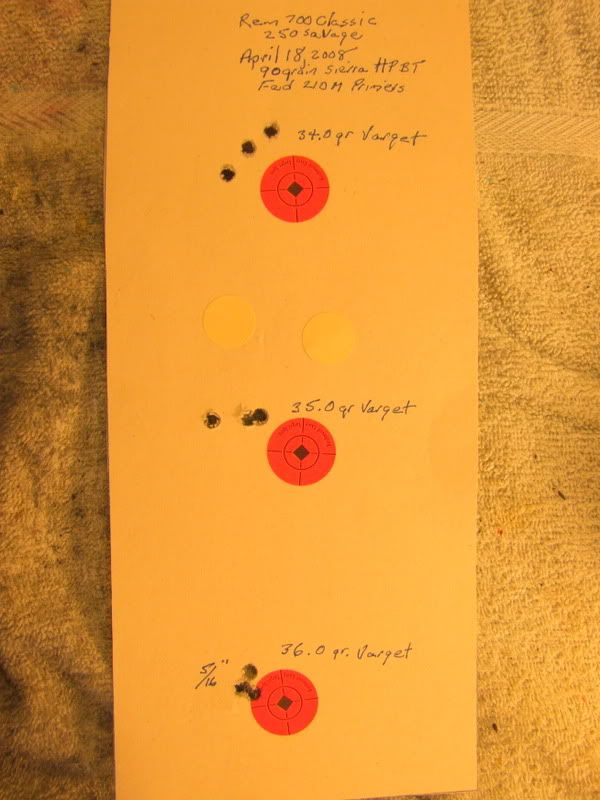  | |||
|
| One of Us |
Did I shoot a zebra at 300 yards with a .223? I'm not aware of it. I have killed coyotes and rock chucks farther than that with a .223 though. Larry Gibson | |||
|
One of Us |
That was a reference to someone else. I do the same as some of you folks, that is, I do the best I can and avoid bumping the shoulder but I use a 'custom' neck sizer with minimum sizing and do not use an expander. I have never weighed my cases - maybe I should! One of my Lee Enfields does not push the case t one side as the extractor gets lifted off the case by the recess but the others do. I rotate the cases in the neck sizer and size them in two or three strokes to keep them straight. There's just not much more I can do about it. Perhaps a new thread on accurate loading, DMB? (I'm not sure I can even aim that accurately!) Regards 303Guy | |||
|
| One of Us |
303, Those groups represent far more than just runout, which is in fact important. I shot centerfire benchrest competetively, and that's where I learned bench technique, which is a part of good groups. Also, when I shoot now, I work real hard at the technique. As an example, for that three shot group I shot with the Rem 722 in 300 Savage, I shot 30 rounds prior to shooting that group with a tricked out Ruger 10-22, just to get in the groove. I shot six 5 shot groups at 50 yards with the 10-22 and got the touch, then I went straight on to shoot the fine group I did with the 300 Sav. I feel it's like basketball players shooting baskets before the game starts, just to get that magic "touch", so when the ball leaves the finger tips, you know it a swish, thru the hoop without touching the rim. I played basketball as a kid in high school. Also, I do weigh cases and sort them by weight. I feel it adds someting to getting good groups. I have a lot of targets from shooting other rifles that are good too. I'm 75, and don't shoot heavy recoiling rifles any longer. I tore a retina in my eye from shooting heavy recoiling rifles, and I don't need that happening again. So, I work with everything below 30 caliber, except for the 300 Sav, and a Rem 722 in 308. I collect Rem 722's, that's the only reason I have a 308, otherwise I would not own one. Also, I had new lenses installed in each eye, so I can actually see again. That helps a lot. But, the accuracy I'm getting with 22 rimfire rifles, 22 Hornets, 222 Rem's, 223's, 222 Rem Mag's, a 22 BR, and a 22-250 are far and away better than I've ever gotten in my life, all because I'm working harder at sorting out all of the variables in the accuracy equation, and handling them. I never shot like I am now with sporters. It's only been the last two, or three years that things are finally coming together. One thing I must single out here, and that is the fantastic accuracy all of the old Rem 722's are delivering, except for the 722AS in 308, and it is BAD. Don't know what's up with that rifle, but it is not shooting. And, I'm in no hurry to fix what's wrong with it. The others are far more accurate than they have a right to be. I only shoot three shot groups for most of the rifles. I know 5 shot groups will be larger than 3 shot groups, but I don't need to shoot 5 shots to prove that fact. I'm not interested in proving anything, just finding the best load possible, and shooting the best that I can. One last point, and that is, I use a 20x scope for bench shooting and switch later to a hunting scope after finding the best load. Don | |||
|
| one of us |
Hey Don, Nice tricks in your post. I always have a 22RimFire with me at the Range, but normally use it while barrels are cooling. Had some fun messing with it last year while trying to beat the groups of a buddy in Califoney. Then Bartsche got a Savage(basically cheated I can see where using the RimFire at first to get the focus and feel going would indeed be a good thing. That sure is some fine shooting. Real glad you and I are not shooting to determine who buys the BBQ for supper. ----- Hey Mark, I should have mentioned earlier that I'd encourage you to try checking for Run Out, with all the tricks of the trade and then compare it to regular old fashioned P-FLRing. It doesn't cost a thing to use another Case to "flex" the errant Bullet in the correct direction, drill a hole in a piece of wood, stick it into a Box End wrench, push it with your thumb, about anything will do - from what I've read here at AR. Looks like the major cost would be the Gauge and Stand to do the Run Out measurements with. Depending on where you work, the Machine Shop might let you take one home over the weekend. Oh yes, the "Find" button at the top of the page should locate enough on all the tricks about Run Out to keep you busy reading until your eyes go bad. And don't expect to "begin" shooting like Don. A person learns a lot of tricks in 75 years as the Trigger Time adds up. Plus, his being able to "see" has a lot of us at a severe disadvantage. | |||
|
One of Us |
Thanks for taking the time DMB. Much appreciated! What you said about 'getting into it' makes sense. Now I am beginning to understand my crap shooting! Now it comes back to me how I might of just fired off the shot somewhat carelessly then wondered why I hit badly or missed. Mmmm.... 22 RF to 'warm up'. How logical and yet I never thought of it! Thanks again! Regards 303Guy | |||
|
| One of Us |
Thanks again. ________________________ "Every country has the government it deserves." - Joseph de Maistre | |||
|
One of Us |
I am sooo grateful for my good vision! I have a few years to go to reach 75 (my Dad turns 90 in a few days so there is hope for me). I really should be putting my vision to good use - like showing up the younsters! (Easier said than done!) But DMB is doing it! (I don't mind been shown up by my superiors - nor anyone else who is good with a gun!) Regards 303Guy | |||
|
| One of Us |
thanx for all the info guys. I tried the rolling method, and I am unable to see anything out of wack. I work at Lancaster arms (AK47 Manufacturer) I will ask one of the guys to check my loads today at lunch and see if they can tell if they are off. I guess I will just have to get a gauge myself. Thanx again. Mark | |||
|
| one of us |
Hey Mark, Good for you. One of the QA folks should be able to help you out on the Measuring. By the way, are you intending on using these Loads in a Bolt Action or in a Semi-Auto? | |||
|
| One of Us |
The loads I am questioning will all be used in bolt action fifle. | |||
|
| Powered by Social Strata |
| Please Wait. Your request is being processed... |
|

Visit our on-line store for AR Memorabilia

